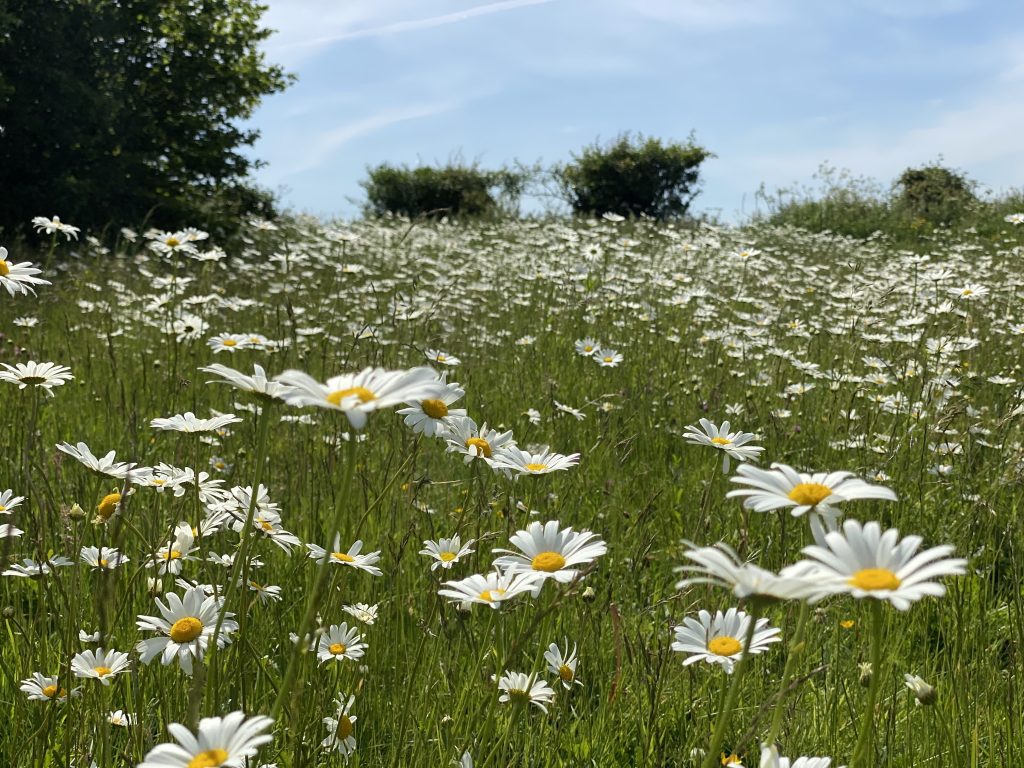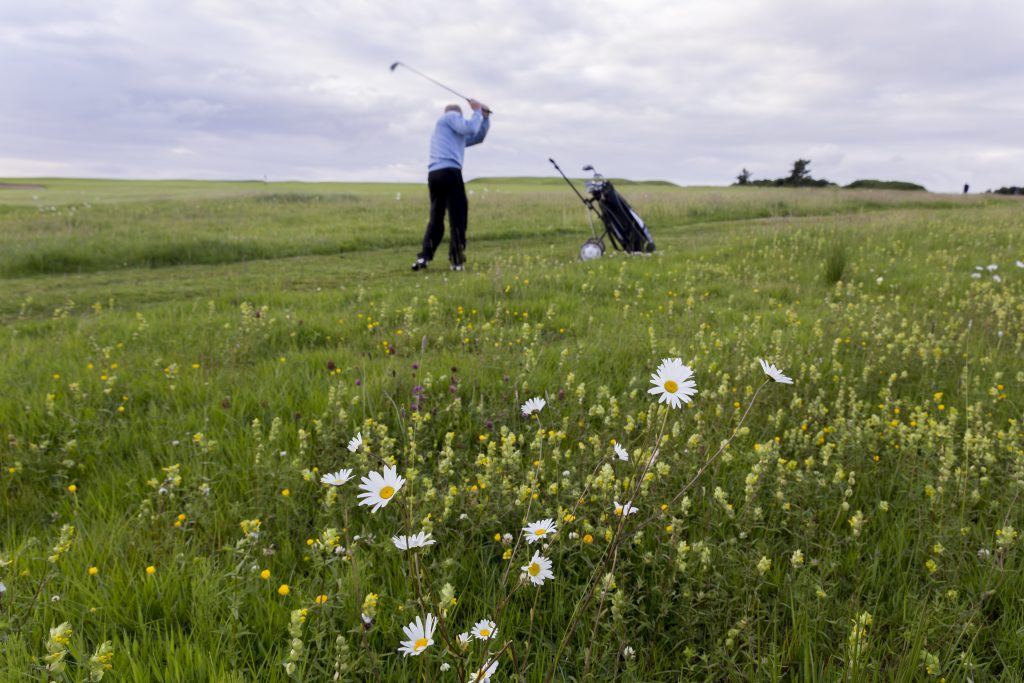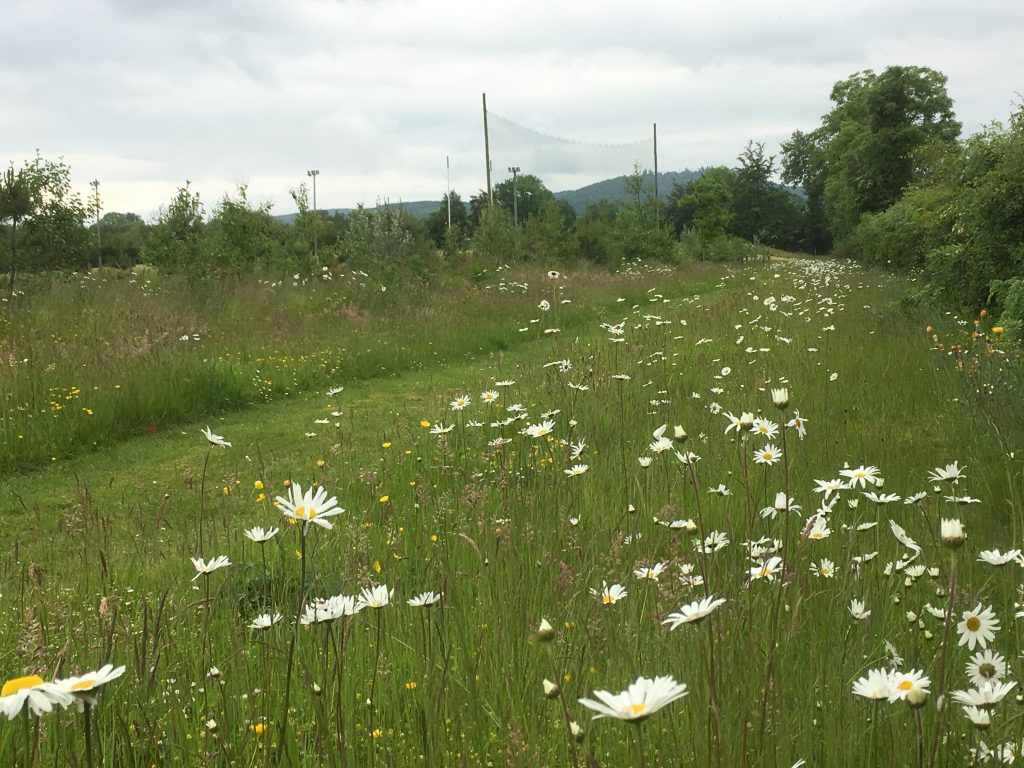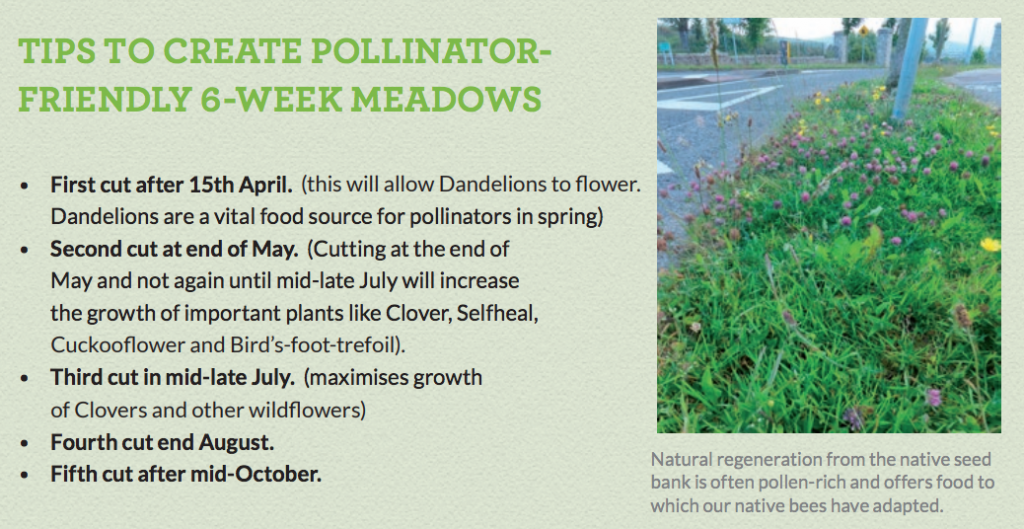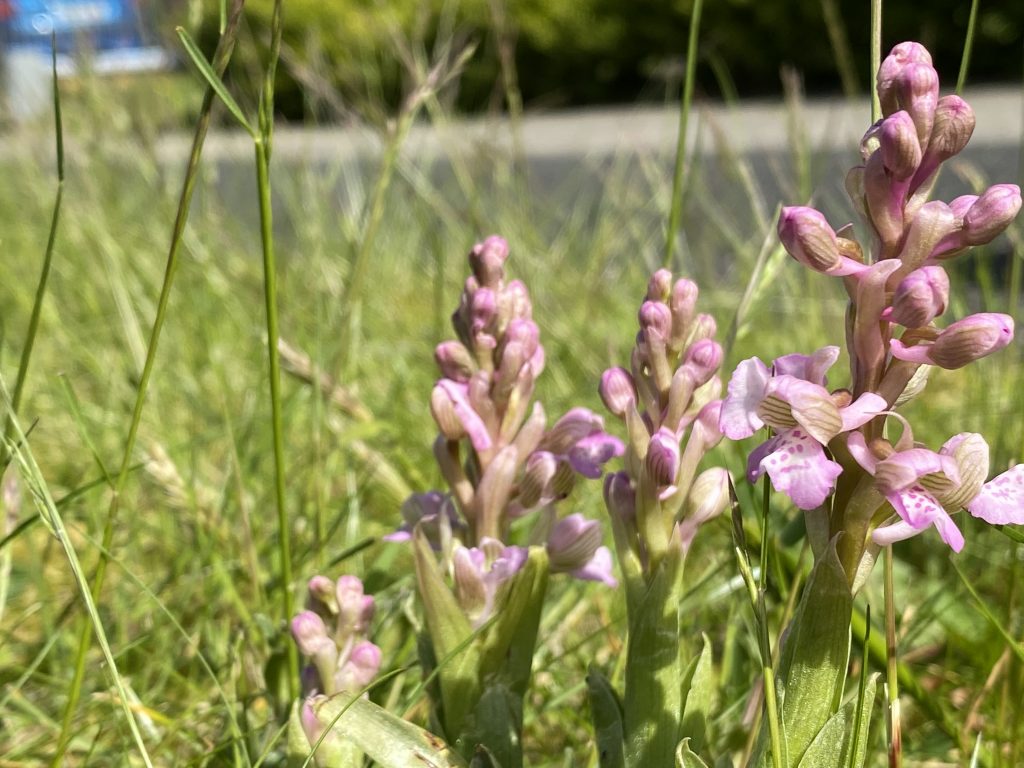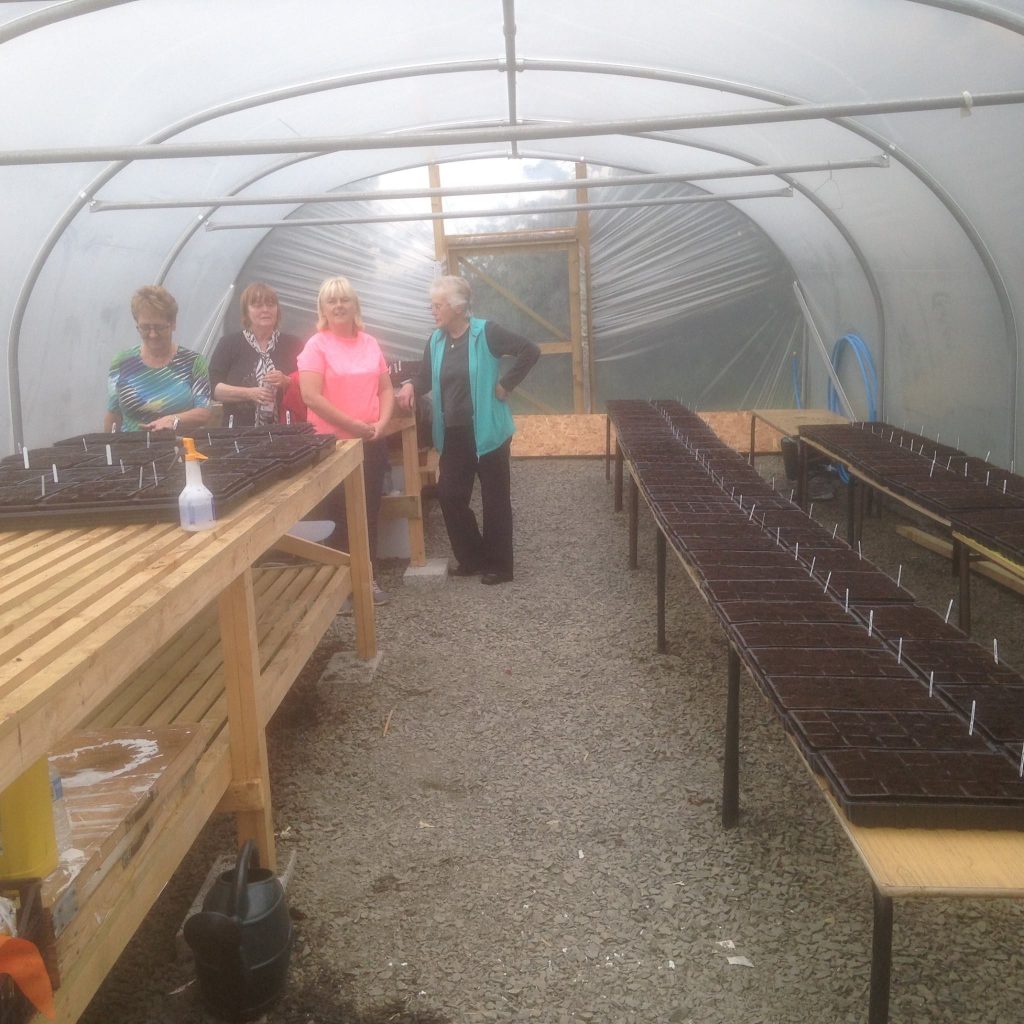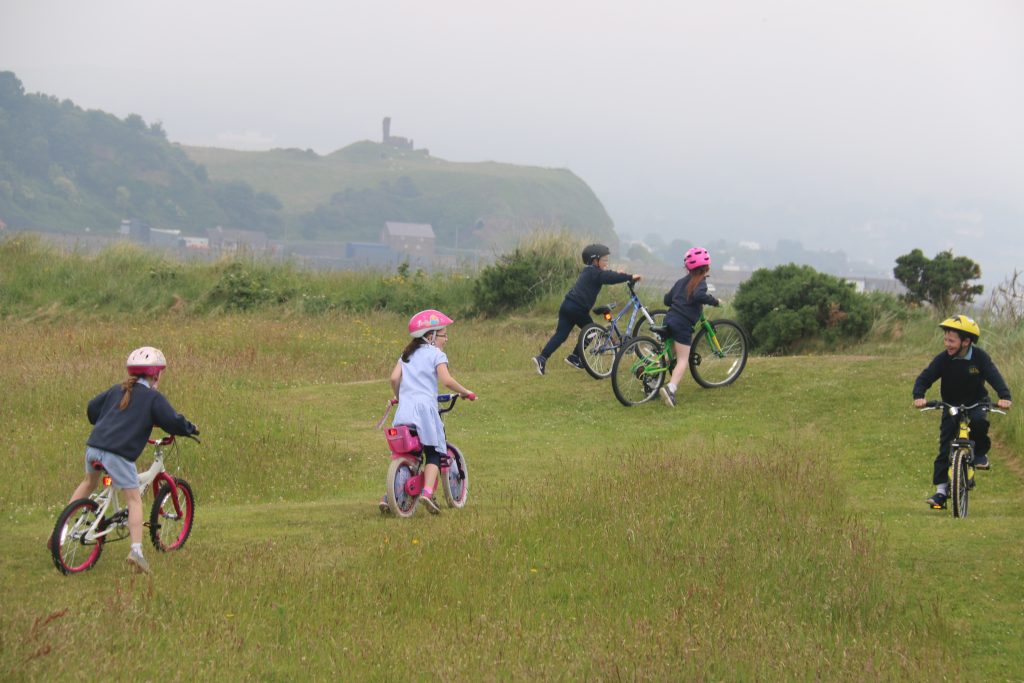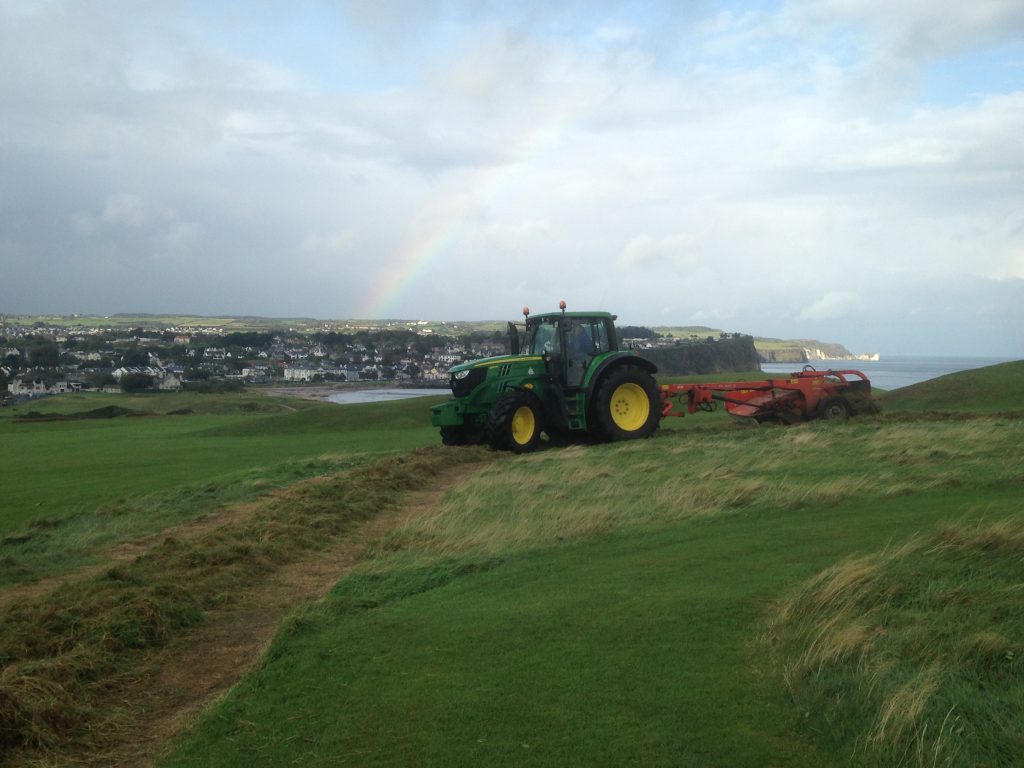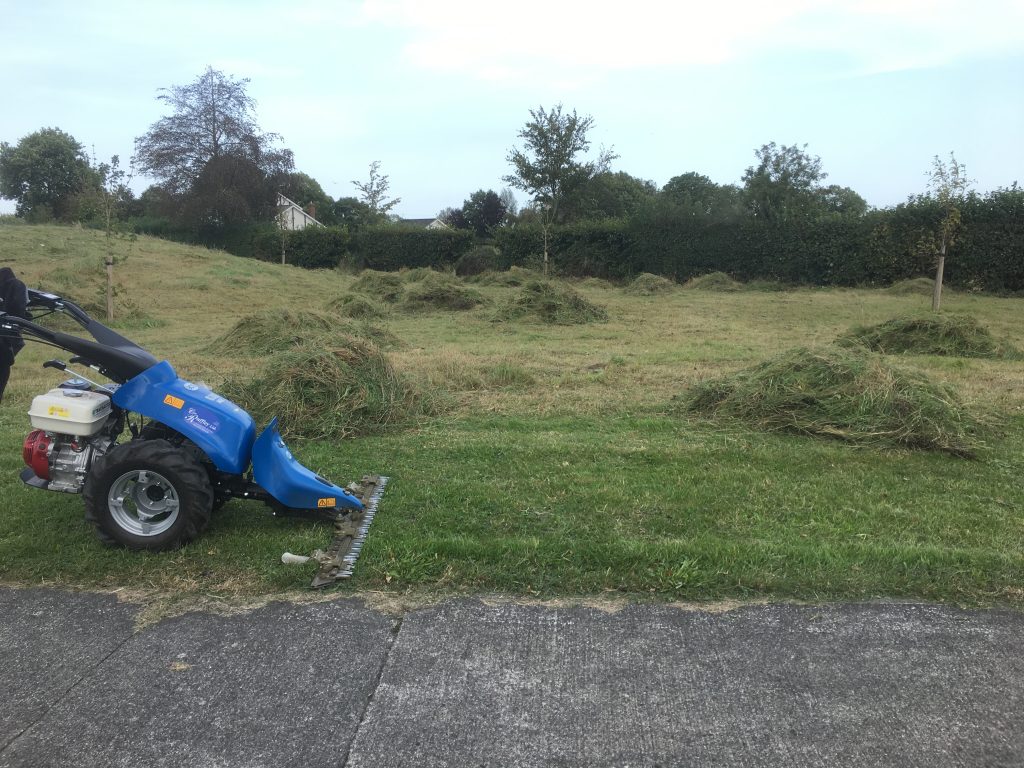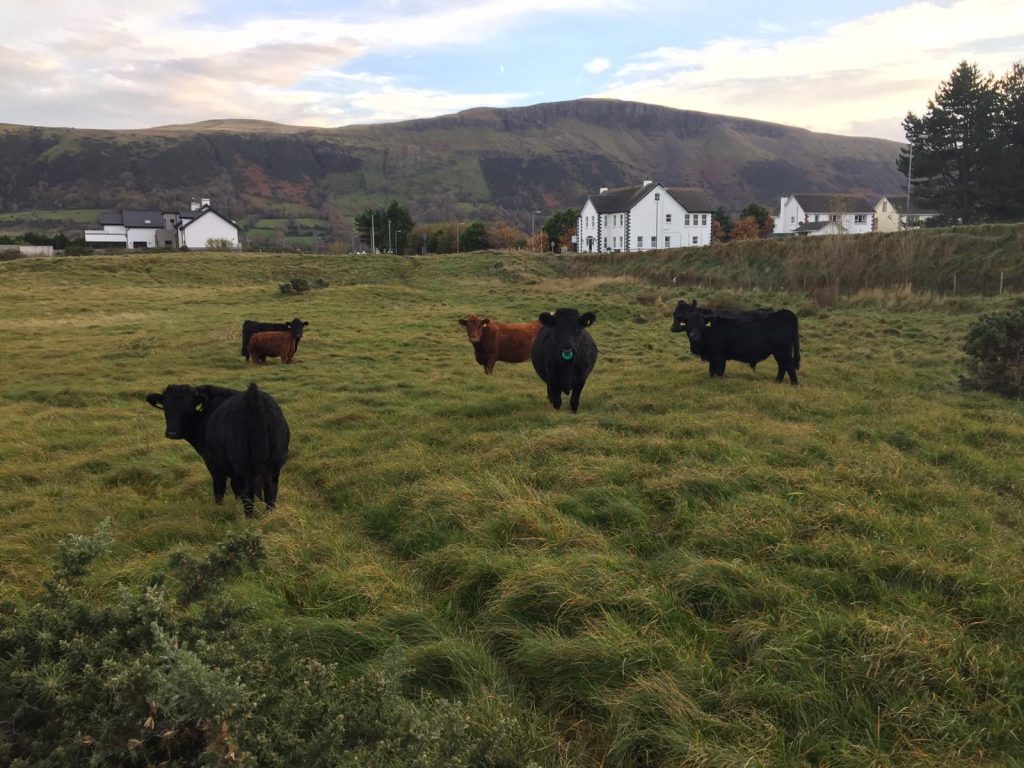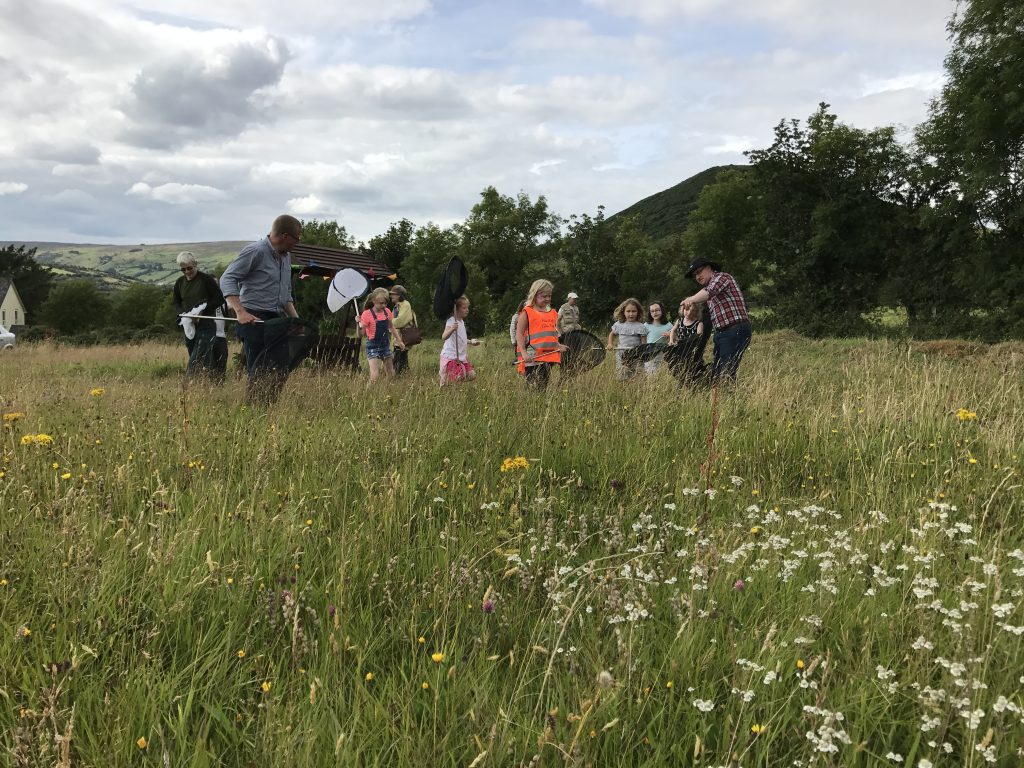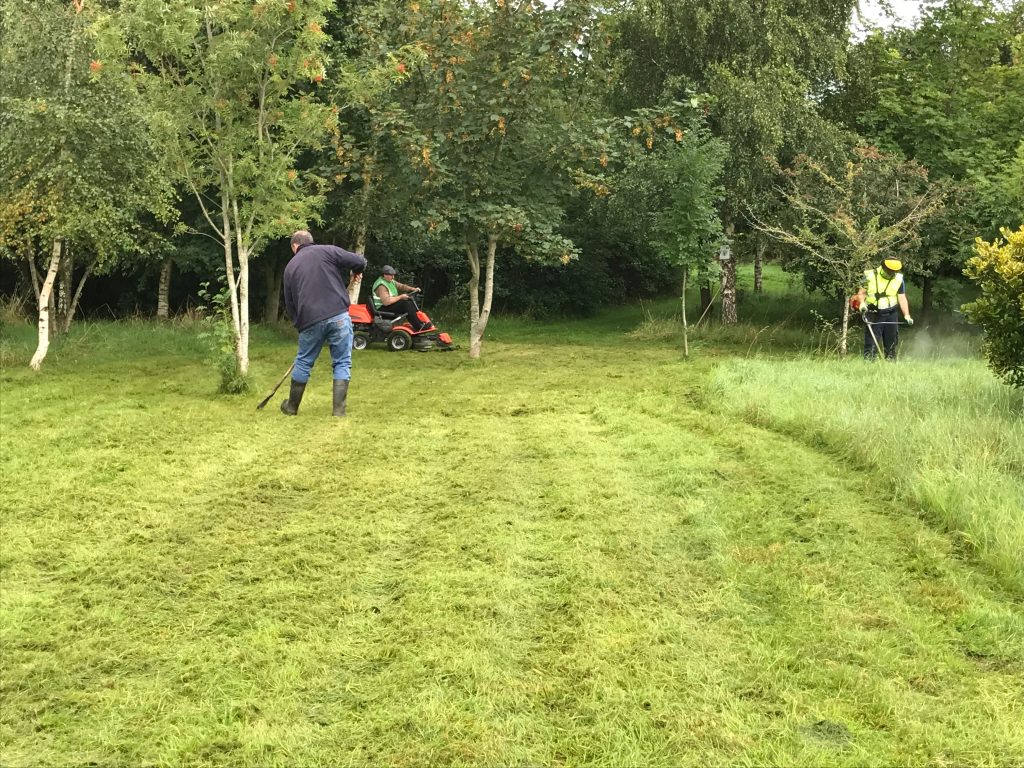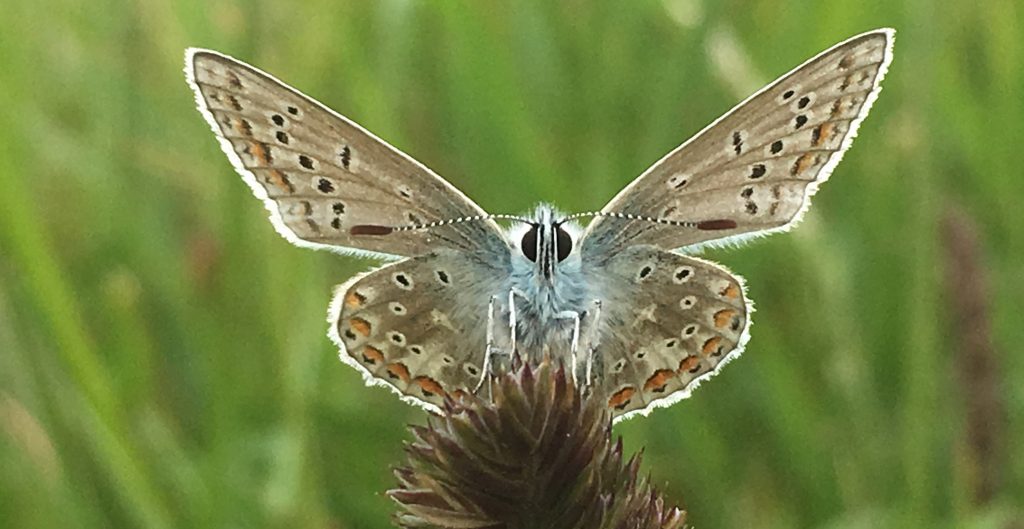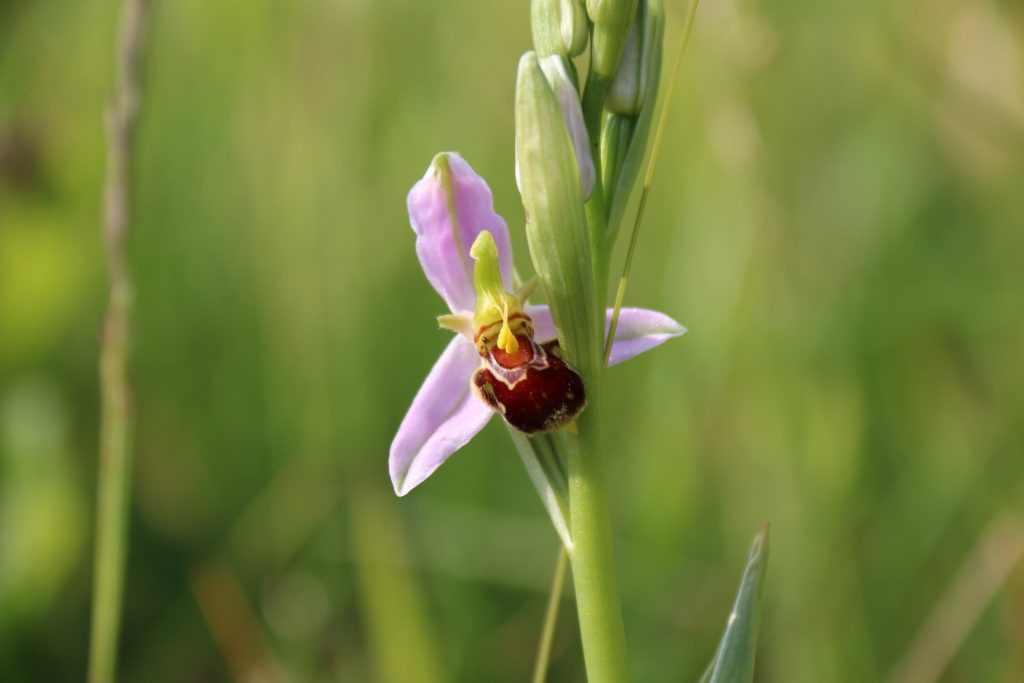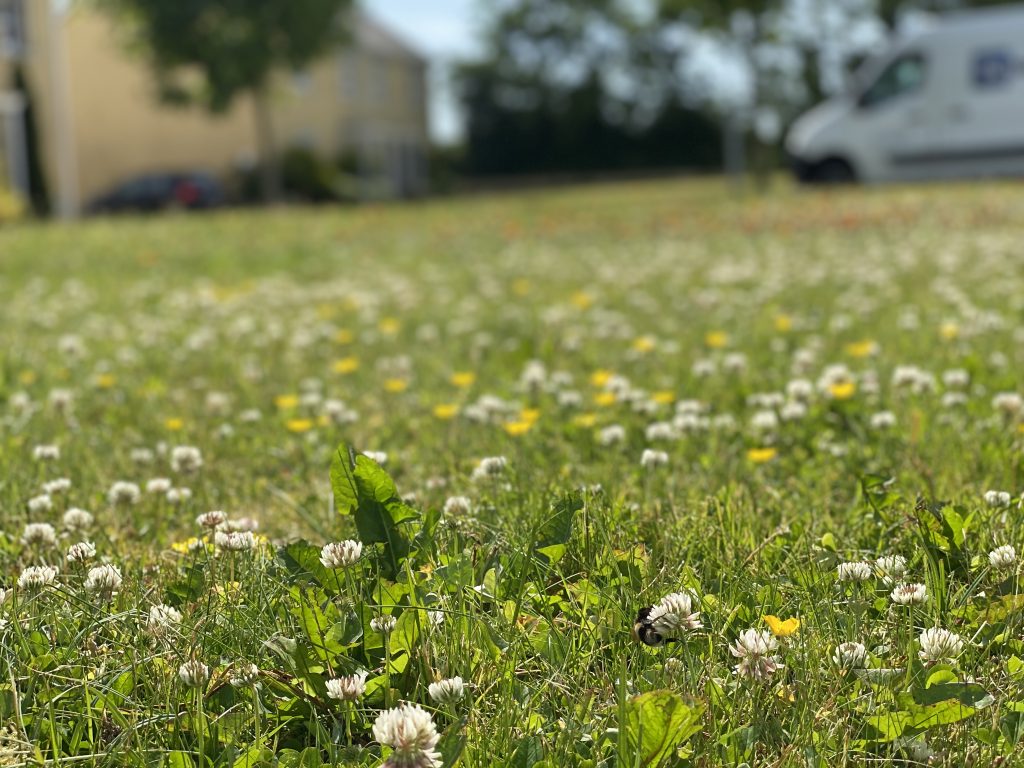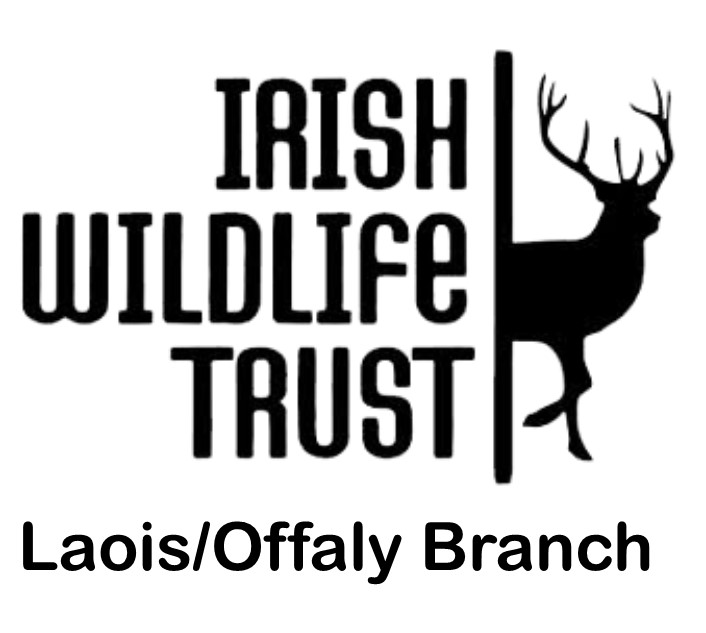Anne Sundermann, Ricky Whelan and Brian Gaynor explain how natural meadows are flourishing under management practices of the Irish Wildlife Trust Laois/Offaly branch
New meadow in a housing estate in Portlaoise
One of the best and most successful ways for communities to promote biodiversity is by converting part of their grass areas to meadow. Here in the Laois Offaly branch of the Irish Wildlife Trust (IWT), we have worked with several community groups to create and manage meadows. We’re happy to share some of our experiences and practical advice here. We have broken this down into four sections:
- Part 1: Our experiences working with community meadows
- Part 2: Starting out – Planning and creating a meadow from scratch
- Part 3: Managing the meadow – Practical tips for managing your meadow throughout the year
- Part 4: Adding value for communities: Involving the community and volunteers
Part 1: Our Experiences working with community meadows
Our branch has been lucky to work alongside some extraordinary community groups and individuals, across both counties, who have really taken on board the whole ethos of the All-Ireland Pollinator Plan. It is largely due to the success of the All-Ireland Pollinator Plan that the public at large has come to realise the problems facing our pollinators and other wildlife, and the steps they can take in their own communities to protect them.
This has led to a surge in interest in creating spaces where pollinators can thrive. The native wildflower hay meadow is one of the most important and easiest of these habitats to create. The meadow can be as big or small as your group can manage and they don’t have to cost anything to create. And the benefits are not just for biodiversity. They can deliver multiple other benefits for us too. With a little bit of thought put into the design they are perfect outdoor playgrounds, the colour and diversity of wildflowers add visual interest throughout the summer, and the potential for volunteer events adds a community element as well. In addition, individual landowners or groups with specific needs may develop a meadow to help meet these needs. For example, healthcare campuses can use them for health and wellbeing purposes, schools for outdoor learning spaces, golf courses for managing the rough areas, etc. We’ll cover examples of these uses later, plus examples of the exciting meadow project in the Glens of Antrim called ‘the Glens Great Grassland Trail’.
Areas of rough in Ballycastle Golf Club are being managed as meadows
As the interest in creating meadows has grown over the last number of years, our branch decided to explore ways to encourage and support local groups in this regard. We provided practical advice on how to create and manage a meadow. This included advice on how to create a new meadow from scratch, which for the majority of cases, just encouraged the groups to change their grass cutting regime, and the basic steps needed to manage a meadow during the year. We’ll be covering these in the following sections.
In 2018, we decided we would go a step further. We wanted to be able to help interested groups get over some of the initial ‘obstacles’ when deciding whether to create a meadow; namely how to cut the long grass at the end of the season. We applied for and received LEADER funding from Laois Partnership Company to purchase equipment to manage meadows, including machinery for cutting the meadows and harvesting wildflower seed. This included a power scythe, with buck and hay rakes; a leaf vacuum for harvesting seed, and an assortment of rakes, wheelbarrows and hay forks. We are not suggesting that this equipment is something that most community groups need to have. It’s relatively expensive and needs to be insured. But given the increased push to create meadows in all communities, we do recommend that local authorities consider adding some of it to their stock of grass-cutting machinery. We also feel that for any local contractors, it may be a wise investment for them to help meet the growing demand for this service.
Over the last four years, we’ve worked with several different groups, including Laois County Council, various Tidy Towns groups, schools, sports clubs (GAA and golf), and residential groups. Between them, they have created new meadows of all different sizes that are helping deliver on the objectives of the All-Ireland Pollinator Plan, while demonstrating to the wider public how wonderful and important these spaces are. For us, it has been very rewarding to see these meadows develop over the years and the pleasure that local people are getting from them. We aim to continue to support local groups going forward and we hope that our shared experience and tips are of some help.
Part 2: Starting Out – Planning and creating a meadow from scratch
The first thing to remember with wildflower meadows is that they are managed habitats. It is not simply a case of letting it grow and walking away. And like any managed landscape, it is best to factor in the maintenance requirements from the outset. With some basic level of planning, wildflower meadows, can be relatively easily created and managed, and deliver a wide range of benefits for the community.
However, as meadows are a move away from what the public has become accustomed to and what those charged with managing as standard community grasslands are set up for, they can create some management challenges. To get over these challenges we encourage all groups to ask themselves a few key questions at the outset:
- What type of meadow do we want and how are we going to create it?
- What do we need to consider during the growing season to keep our meadow looking its best?
- How are we going to manage the end of season cut and lift (for hay meadows)?
- How can we maximise our meadow for community use and engage the public?
Wildflower meadow in Portlaoise GAA grounds
What type of meadow?
There are a few types of meadow suitable for community green spaces such as parks or residential estates: the short-cut meadow (involving a cut and lift* approximately every 6 weeks); and the hay meadow (1 or 2 cut and lifts per year); or the spring bulb meadow (use pollinator-friendly bulbs).
[*When developing a wildflower area, the best guidance is always to remove all cuttings. This helps to keep soil fertility at a minimum which encourages wildflower growth (leaving cut grass or mulching adds fertility to the soil and will only encourages grasses to grow which out-compete the wildflowers in the seed bank).]
Deciding on which style to go with will depend on several factors, some of which are listed here:
- Visual:
- For some communities / individuals the idea of a tall meadow on their green spaces may be a step too far. In such circumstances, then one of the other two meadow types may act as a compromise. For others, the hay meadow with paths cut through it, will be perfectly acceptable and indeed will enhance their green space.
- If the soil is very nutrient rich and the sward species poor to begin with, then it could take several seasons of management before the meadow begins to resemble what most people would recognize – a grasslands full of wildflowers and colour. Again, in this case you may consider starting with a short-cut meadow (every six weeks) initially before transitioning to the hay meadow (annual cut).
- Management: Have you the capacity to manage cutting and lifting longer grass or the end-of-season cut required for a hay meadow?
- Community Use: Some green spaces may be required at certain times of the summer for community events, but for the rest of the year they may be lying idle and serve no function. In such cases, these areas could be managed as short-cut meadows and then cut as required for community use.
You don’t have to limit yourself to just one meadow type. Spring bulbs can be added into any meadow to extend the flowering season and maximise biodiversity value. Similarly, you can manage different sections of your grassland differently. A transition from short-cut meadow to hay meadow to woodland or/ hedgerow is visually very attractive in large green spaces and has great biodiversity value.
Wildflower-rich spaces outside of grassland areas may also be created and enhanced. Community woodlands, particularly new woodlands, may benefit from management that opens and encourages space for flower-rich glades. The bases of hedgerows and stone walls are also great places to consider strips of meadow. These spaces should be designed and created with guidance from experienced persons in your community or by professionals.
Creating your meadow
To create a meadow from an existing grassland, we always advise groups to work with what is there. This approach avoids the use of herbicide to clear vegetation, which has damaging environmental issues, and minimizes costs for your group.
Each site will be different. Some meadows may require more patience to get them to a place where they have a good mix of grasses and wildflowers. Others will be full of colour in the first year. You may even be fortunate enough to find a rare or unusual wildflower in your meadow. This was the case this year when a housing estate in Portlaoise recorded a Green-winged Orchid (Anacamptis morio) in their grass verge after it was left uncut. The most important thing is to put in place the proper management regime for your meadow and to follow that through every year. You should find that your meadow will improve each year.
Green-winged orchid found growing in a housing estate in Portlaoise in 2020, the first time it was recorded in the area in over 100 years!
You can speed up the process and give nature a helping hand by harvesting local wildflower seed for your meadow. This is an easy exercise to carry out; all you need is a small container or pillowcase with you when you go on a walk and collect seed growing wild on roadside verges or other flower-rich sites. This can be spread on your meadow after it has been cut and lifted at the end of the season. Particular attention should be given to the wildflower Yellow rattle (Rhinanthus minor). Also known as nature’s lawnmower, this is an invaluable species to have in all hay meadows. This link from the UK has everything you need to know about it (https://www.plantlife.org.uk/uk/discover-wild-plants-nature/how-to-grow-yellow-rattle-rhinanthus-minor).
You could also consider growing some of your collected wildflower seed as plugs over the winter, for planting out the following spring. We have found that this is a great way of involving the local community with their meadow by; 1) working with local groups (could include local schools) to grow on the seed in their polytunnels; and 2) the planting of the plugs in the spring can act as a volunteer event as well, similar to a tree planting day.
Members of Tieveragh Allotment Garden in Cushendall tending to the thousands of wildflower plugs grown from locally harvested wildflower seed
Other meadow features to consider
Some of the other things you’ll need to consider when creating your meadow include:
- Signage: it is important to let people know what you are doing and why. Simple signs such as the All-Ireland Pollinator Plan’s signage (https://pollinators.ie/resources/signage-templates/) can be used. We have also used 6” square posts and designed simple signs for the faces of each. This is a permanent and relatively inexpensive way of raising awareness.
Wildlife interpretation post used on the Glens Great Grassland Trail in Antrim
- Access to the site: it is worth considering access to the site for maintenance, especially if you are planning on managing it with large machinery. For example, any gates should be wide enough to allow access for maintenance equipment / machinery.
- Other community activities: engage with local community groups and the younger members of the community to identify the main areas for recreation, and create the meadow away from these spaces.
- Other biodiversity features: Your new meadow can complement other existing or new biodiversity features. Tree planting, bee boxes and banks, bat boxes, wildlife ponds, etc. alongside your meadow will increase biodiversity in your community.
Part 3: Managing the Meadow – Practical tips for managing your meadow throughout the year
Managing your meadow during the growing season
For the most part, your meadow will involve minimal maintenance during the year. However, there are a few things you need to keep in mind:
- Mown Paths / Fringes: For all meadows, we recommend that groups mow the fringes of footpaths, car parks or roads to maintain a neat, tidy and sharp appearance. Cutting a single mower-width strip around perimeter is usually enough. For larger meadows, we suggest mowing meandering paths through them. These paths should take into account desired lines and points of interest along the way.
Pathways will help draw people into the meadows and can significantly increase the amount of walking trails and natural play opportunities in your community. A good example of this can be seen on the Glens Great Grassland Trail in Antrim, where the local primary school was involved in the layout of the mown paths. They incorporated the humps in the ground into the path network so the meadow doubled up as a natural play area including for BMX cycling.
Meadow paths are great for inviting people inwards to use the meadow and for natural play. During planning of meadows for the Glens Great Grassland Trail in Antrim, the local primary school was involved in the layout of the mown paths for BMX cycling tracks.
A Note on Noxious Weeds: The control of noxious weeds often raises lively debates amongst conservationists. These wildflowers are native and valuable wildflowers for biodiversity. However, it is important that groups understand that there is legislation regarding the control of noxious weeds, and it is the responsibility of the landowner / occupier to control the growth and spread of these species from their land. We recommend that groups control noxious weeds by removing manually before they go to seed, and use proper protective gear. In addition; if the plan for the hay involves it being taken by a local farmer as bales, it must be remembered that the presence of these species can be harmful to livestock.
Cutting your meadow
A hay meadow requires a cut and lift (removal of the hay from the meadow area) at the end of the season. This is typically in September (although if your meadow is rich in late flowering species you may wish to delay this to allow them to set seed). A second cut and lift may be required in early spring to remove winter growth.
Hay meadows significantly reduce the amount of time spent on grass-cutting during the growing season, but they do pose a few challenges at the end of the season:
- How are you going to cut it?
- How are you going to gather and remove the hay from the meadow area?
- What are you going to do with the hay?
As standard lawnmowers (push or ride-on mowers) will not be able to cut long meadows, you will need to find alternative solutions. Much will depend on the size of the meadow and availability of volunteers or contractors with the right machinery. For larger meadows, it is worth checking if there are any local farmers or grass contractors who are willing to cut and bale the grass for you.
Example of a meadow in the Glens of Antrim being cut with the hay baled and used by a local farmer
For small- to medium-size meadows, smaller tractors (similar to those used on sports grounds) and mechanical equipment like power scythes and brush cutters are ideal. There is also the traditional handheld scythe, which in the hands of a skilled operator is very effective. A word of caution; care should be taken when using any of this equipment as any accidents with them can be serious.
You also need to consider how you are going to gather the cuttings and remove them from the meadow area. The hay should first be gathered into rows which are then gathered into individual stacks similar to traditional haycocks. These are then gathered up and removed from the meadow. If you are getting a contractor to cut the meadow it is worth getting them to manage this part as well.
Another time and potential cost saving measure is to check if there are other local groups with meadows. If so, there may be an opportunity to join forces for the end of season cut that will benefit all parties.
As we expand the amount of community meadows throughout the country, there is a growing case for local authorities and contractors to invest in machinery capable of managing meadows. The role of community groups here is to encourage them to do so, and support local contractors that do make this investment.
The power scythe we purchased in 2018, used to help the local Tidy Towns group manage an area of meadow in Portlaoise
There are two other options we are going to quickly consider: First, if the meadow is large and secure, or if there is the potential to secure it, then conservation grazing may be an option. This is a great way of managing the meadow and can add interest to the site during the off-season. Traditional breeds of cattle are ideal to carry out this job.
Example of a meadow in Glenariff in the Glens of Antrim being managed using conservation grazing (a local farmer with Dexter cattle grazes it over the winter)
The second option is to engage with local vintage groups or farmers with traditional hay meadow machinery that would be interested in getting involved. This could solve all the management issues and create a nice community heritage event (and if you cut at the end of August, it will coincide with National Heritage Week!). You could even carry out traditional scything and hay stacking demonstrations as part of such an event.
Part 4: Adding Value for Communities: Involving the community and volunteers
A community wildflower meadow creates opportunities for a range of community events and Citizen Science activities. Below are some of the events we have tied in with our meadow work:
General maintenance volunteer events/days:
- Cutting and lifting the meadow; if the meadow is of a manageable size, then enlist volunteers. This task can also be further developed into a Heritage Week event involving the whole community, particularly if there are local vintage groups interested in getting involved.
- Enrichment planting / seeding of the meadow; this in itself creates several opportunities to involve volunteers including:
- Seed harvesting locally, done by individuals in their own time over the summer months or as part of an organised day at a suitable donor site [with the permission of the relevant landowner(s)]
- Spreading the seed after the cut and lift
- Growing some seed on as plug plants; this is a great chance to involve local schools and allotment groups in the process (ideally done in a polytunnel)
- Plug planting; creates another community event in the springtime.
Community walks and talks:
Meadows have so much more wildlife value than areas of mown grass and therefore are ideal places for wildlife walks and talks. They are perfect for projects / events based around pollinators.
A bumblebee identification event, one of the many community events being delivered in the meadows on the Glens Great Grassland Trail
Outdoor Learning & Citizen Science:
Given the biodiversity value of meadows, they act as great places for outdoor classrooms and for Citizen Science activities. It is worth engaging with local schools when creating your meadows so that they are aware of this wonderful amenity on their doorstep. Consider adding in signage to further raise awareness and understanding of the meadow.
Natural Play:
Meadows can act as great outdoor play spaces by simply mowing paths through them. Both children and adults will find these much more interesting than large areas of mown grass.
| Tips for a Healthy Meadow: |
|
Video from Portlaoise Tidy Towns
Sincere thanks to Brian Gaynor, Ricky Whelan and Anne Sundermann the Laois/Offaly Branch of the Irish Wildlife Trust.

